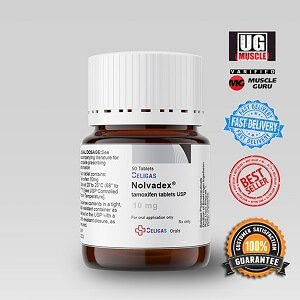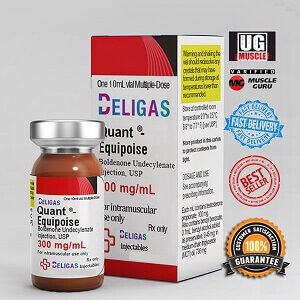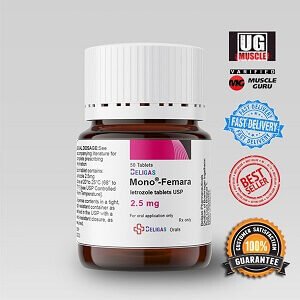Introduction to Nolvadex and Post-Cycle Therapy (PCT)
Nolvadex, or Tamoxifen Citrate, originates as a selective estrogen receptor modulator (SERM) developed initially for treating breast cancer. Its primary function is to block estrogen receptors in breast tissue, which inhibits the growth of hormone-responsive cancer cells. Over time, Nolvadex has found applications beyond oncology, particularly within the realm of fitness and bodybuilding, where it has been utilized extensively in Post-Cycle Therapy (PCT).
Post-Cycle Therapy (PCT) is an essential protocol undertaken by individuals following the completion of a cycle of anabolic steroids. Anabolic steroid cycles often disrupt the body’s natural hormonal balance, leading to suppressed testosterone levels. PCT aims to stimulate natural testosterone production, restore hormonal equilibrium, and prevent potential long-term damage. Nolvadex plays a critical role in this process.
The necessity for PCT arises due to the body’s physiological response to exogenous anabolic steroids. When external anabolic agents are introduced, the body’s endogenous testosterone production may reduce significantly or cease altogether. This suppression can lead to adverse effects such as muscle loss, fat gain, emotional fluctuations, and lowered libido. Implementing a PCT regimen helps mitigate these issues by promoting the endogenous production of testosterone and rebalancing hormone levels.
Nolvadex fits seamlessly into PCT protocols by virtue of its ability to antagonize estrogen receptors. During and after anabolic steroid cycles, elevated estrogen levels can lead to complications such as gynecomastia and water retention. Nolvadex helps prevent these estrogen-related side effects by binding to estrogen receptors and inhibiting estrogenic activity in specific tissues. Furthermore, Nolvadex stimulates the release of gonadotropins such as luteinizing hormone (LH) and follicle-stimulating hormone (FSH), which are pivotal in signaling the testes to resume natural testosterone production.
In summary, Nolvadex is a vital component in PCT, aiding in the restoration of natural testosterone levels and mitigating estrogenic side effects. Its use ensures that individuals recover more effectively and maintain the gains achieved during anabolic steroid cycles within a balanced hormonal environment.
How Nolvadex Works in PCT
Nolvadex, known generically as tamoxifen citrate, plays a pivotal role in post-cycle therapy (PCT) due to its biochemical mechanisms. As a Selective Estrogen Receptor Modulator (SERM), Nolvadex exhibits a dualistic approach by either blocking or activating estrogen receptors in varying tissues, which is crucial during PCT for individuals recovering from anabolic steroid cycles.
By occupying estrogen receptors in breast tissue, Nolvadex inhibits the estrogenic stimulation that could otherwise lead to gynecomastia, a common concern for steroid users. This action is paramount in preventing the development of male breast tissue, providing considerable relief for those susceptible to estrogenic side effects.
The mechanism by which Nolvadex mitigates estrogen levels can be understood through its competitive inhibition. In essence, Nolvadex binds to estrogen receptors with high affinity, thereby preventing the actual hormone from exerting its effects. This helps moderate the body’s estrogen levels, crucial for maintaining hormonal balance during PCT.
Moreover, Nolvadex positively influences the hypothalamic-pituitary-gonadal (HPG) axis. Its anti-estrogenic activity sends a signal to the hypothalamus, prompting it to release gonadotropin-releasing hormone (GnRH). This, in turn, stimulates the pituitary gland to produce luteinizing hormone (LH) and follicle-stimulating hormone (FSH), which are critical for endogenous testosterone production. The increased levels of LH and FSH enhance the testicular function, thereby promoting natural testosterone synthesis that is often suppressed during anabolic steroid usage.
Through these biochemical pathways, Nolvadex not only aids in reestablishing the body’s natural hormonal equilibrium but also serves as an effective countermeasure against estrogen-related complications. Its multifaceted role in post-cycle therapy underscores its importance for individuals aiming to maintain muscle gains and hormonal health after steroid cycles.
Implementing Nolvadex in Your PCT: Dosage and Timing
Incorporating Nolvadex into your Post Cycle Therapy (PCT) regimen effectively is crucial for mitigating the adverse effects of anabolic steroid use and promoting the body’s natural hormone production. The following guidelines provide detailed insights into typical dosages, administration timing, and the duration of Nolvadex use for different steroid cycles.
Short Cycles (4-6 weeks): For shorter steroid cycles, it is recommended to commence Nolvadex approximately 2-3 days after the last steroid dose. The standard dosage typically starts at 20 mg per day for the first 2 weeks. Following this, the dosage can be reduced to 10 mg per day for the remaining 2-3 weeks, ensuring a total PCT duration of 4-5 weeks. This approach supports steady hormonal recovery without overwhelming the system.
Moderate Cycles (6-10 weeks): For medium-length cycles, initiating Nolvadex should occur 3-5 days post the final steroid dose. A suggested protocol includes 20 mg to 40 mg per day for the initial 2 weeks, followed by a reduction to 10 mg to 20 mg per day for the subsequent 3-4 weeks. This extended duration aids in a more comprehensive hormonal rebalance and supports recovery over a slightly stretched timeline.
Long-Term Cycles (10+ weeks): For prolonged steroid use, it is advisable to begin Nolvadex within 5-7 days after the last steroid dose. The initial dosage in this scenario often ranges from 40 mg to 50 mg per day for the first 2 weeks, tapering down to 20 mg per day for the next 4 weeks. Depending on individual requirements, some may extend the usage at 10 mg per day for an additional few weeks, ensuring a robust recovery process.
Adjusting Dosages: Individual responses to Nolvadex may vary, necessitating personalized dosage adjustments. If symptoms of estrogen rebound or inadequate recovery are observed, it might be beneficial to either prolong the duration of dosage tapering or increase the starting dose slightly. Consulting with a healthcare professional before making any adjustments ensures safety and effectiveness.
Customized PCT protocols paired with carefully calibrated Nolvadex dosages can significantly enhance recovery, helping users restore hormonal balance effectively and maintain the gains achieved during their steroid cycle without compromising health.
Potential Side Effects and Considerations
Nolvadex, often used in post-cycle therapy (PCT), has a range of potential side effects that users should be aware of. While generally well-tolerated, Nolvadex can cause certain adverse reactions, some of which are common while others are more rare. Recognizing these side effects and understanding how to manage them is crucial for anyone considering Nolvadex in their PCT regimen.
Common side effects of Nolvadex include hot flashes, gastrointestinal issues, and fatigue. Hot flashes are typically characterized by sudden feelings of warmth, often accompanied by sweating and reddening of the skin. Gastrointestinal issues might manifest as nausea, stomach cramps, or constipation. Fatigue, while less common, can lead to decreased energy levels and overall lethargy. These side effects are generally mild and often diminish as the body adjusts to the medication.
More serious but rare side effects include visual disturbances, blood clots, and changes in blood lipid levels. Visual disturbances might involve blurred vision or difficulty focusing. Blood clots present a significant health risk and can lead to deep vein thrombosis or pulmonary embolism. Alterations in blood lipid levels, while less immediately obvious, can impact cardiovascular health over time. Due to these potential risks, it is essential to monitor your body’s response to Nolvadex closely.
Managing and mitigating the side effects of Nolvadex starts with adherence to the prescribed dosage and timing. Staying hydrated, maintaining a balanced diet, and incorporating regular exercise can also help to minimize adverse reactions. If experiencing hot flashes, wearing lightweight clothing and ensuring a cool environment can provide some relief. For gastrointestinal issues, consuming smaller, frequent meals and avoiding heavy, greasy foods may alleviate symptoms.
It is also important to consider who should avoid using Nolvadex. Individuals with a history of blood clotting disorders, certain visual impairments, or abnormal blood lipid levels should consult their healthcare provider before starting Nolvadex. Continuous monitoring of your body’s response and seeking medical advice if severe side effects occur is vital.
In conclusion, while Nolvadex PCT has its benefits, awareness and management of potential side effects are key to a safe and effective therapy journey.





Reviews
There are no reviews yet.